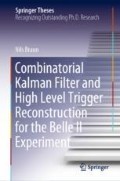Abstract
The High Level trigger (HLT) plays a crucial role for the success of an experiment, as pointed out in Sect. 2.2. Its decision logic, which defines whether a collision event is accepted or discarded, defines which physical results can be extracted from the collected data and whether a certain analysis has enough statistics to be possible at all. A sub-optimal event selection at this stage looses them irretrievably.
Access this chapter
Tax calculation will be finalised at checkout
Purchases are for personal use only
Notes
- 1.
There is a subtle difference between the reconstruction with a single process and single-core processing as introduced in Fig. 2.8. In this thesis, only the worker processes are counted, so the reconstruction on a single process uses actually three cores: one for the worker, one for the output and one for the input process (cf. Sect. 2.3). All the studies in the following are normalized to this case.
- 2.
The grid sites used for simulating as well as reconstructing events after the recording will allow for jobs using multiple cores in the future. Also the local development today is mostly performed on multi-core machines where multiprocessing can speed up the development time significantly.
- 3.
As this is of course not possible because of hardware constraints, the limit should at least be much larger than the average raw data size.
- 4.
The event buffer size can be controlled via module parameters and set to two by default.
References
Urquijo P, Ferber T (2016) Overview of the Belle II physics generators. https://docs.belle2.org/record/282/files/BELLE2-NOTE-PH-2015-006-v2.pdf
Iwasaki Y, Cheon B, Won E, Gao X et al (2011) Level 1 trigger system for the Belle II experiment. IEEE Trans Nucl Sci 58(4):1807–1815. http://ieeexplore.ieee.org/document/5740389/, https://doi.org/10.1109/TNS.2011.2119329
Shiu J-G (2016) The level 1 trigger system for Belle II CDC. In: 2016 IEEE-NPSS Real Time Conference (RT), pp 1–3. IEEE. http://ieeexplore.ieee.org/document/7543137/
Kim S, Lee I, Unno Y, Cheon B (2017) Status of the electromagnetic calorimeter trigger system at Belle II. J Phys Conf Ser 928:012022. http://iopscience.iop.org/article/10.1088/1742-6596/928/1/012022/pdf
Belle II Collaboration (2019) Basf2 software repository trigger package. https://stash.desy.de/projects/B2/repos/software/browse/trg?at=refs%2Ftags%2Frelease-02-00-01
Kuhr T, Pulvermacher C, Ritter M, Hauth T, Braun N (2018) The Belle II core software. arXiv:1809.04299
Intel Corporation (2014) Intel® Xeon® Processor E5-2660 v3 (25M Cache, 2.60 GHz) Produktspezifikationen. https://ark.intel.com/de/products/81706/Intel-Xeon-Processor-E5-2660-v3-25M-Cache-2_60-GHz
Amdahl GM (1967) Validity of the single processor approach to achieving large scale computing capabilities. In: Proceedings of the April 18–20, 1967, Spring Joint Computer Conference on–AFIPS ’67 (Spring). ACM Press, New York, USA. http://delivery.acm.org/10.1145/1470000/1465560/p483-amdahl.pdf?ip=129.13.102.208&id=1465560&acc=ACTIVESERVICE&key=2BA2C432AB83DA15.50F04DEC6D8CC69A.4D4702B0C3E38B35.4D4702B0C3E38B35&__acm__=1537457854_f3487ed1102f3a71b6429db4d2d5670a, https://doi.org/10.1145/1465482.1465560
Yamada S, Itoh R, Nakamura K, Nakao M et al (2015) Data acquisition system for the Belle II experiment. IEEE Trans Nucl Sci 62(3):1175–1180. http://ieeexplore.ieee.org/document/7117478/, https://doi.org/10.1109/TNS.2015.2424717
Asner DM, Dart E, Hara T (2013) Belle II experiment network and computing. arXiv:1308.0672
Marr DT, Hinton G, Koufaty DA, Miller JA (2002) Hyper-threading technology architecture and microarchitecture. http://www.cs.virginia.edu/~mc2zk/cs451/vol6iss1_art01.pdf
Intel Developer Forum (2002) Intel demonstrates breakthrough processor design. https://www.intel.com/pressroom/archive/releases/2001/20010828comp.htm
Levinthal D (2008) Performance analysis guide performance analysis guide for Intel® Core\(^\text{TM}\) i7 processor and Intel® Xeon\(^\text{ TM }\) 5500 processors. http://www.intel.com/technology/hyperthread/index.htm;
Vitillo RA (2011) Performance tools development. Futur Comput Part Phys 16. https://indico.cern.ch/event/141309/contributions/1369454/attachments/126021/178987/RobertoVitillo_FutureTech_EDI.pdf
Salzburger A (2015) Optimisation of the ATLAS track reconstruction software for run-2. J Phys Conf Ser 664:072042. IOP Publishing. http://stacks.iop.org/1742-6596/664/i=7/a=072042?key=crossref.c1d153f8aa8896687664b45b57a803d5, https://doi.org/10.1088/1742-6596/664/7/072042
Meyer J (2016) Optimisation of the material parameters for track fitting in the central drift chamber of the Belle II experiment. Bachelor’s thesis, KIT. https://ekp-invenio.physik.uni-karlsruhe.de/record/48884/files/EKP-2017-00011.pdf
Gumpert C, Salzburger A, Kiehn M, Hrdinka J, Calace N (2017) ACTS: from ATLAS software towards a common track reconstruction software. J Phys Conf Ser 898:042011. http://iopscience.iop.org/article/10.1088/1742-6596/898/4/042011/pdf, https://doi.org/10.1088/1742-6596/898/4/042011
Hearty C (2018) Jira issue on HLT phase 2 menu. https://agira.desy.de/browse/BII-3617?focusedCommentId=44831&page=com.atlassian.jira.plugin.system.issuetabpanels%3Acomment-tabpanel#comment-44831
Adam W, Bergauer T, Deldicque C, Erö J et al (2006) The CMS high level trigger. Eur Phys J C 46(3):605–667. http://www.springerlink.com/index/10.1140/epjc/s2006-02495-8
Nakamura T (2001) Study of the level 3 software trigger system with the silicon vertex detector for the belle experiment. Master’s thesis, Tokyo Institute of Technology. http://www.hp.phys.titech.ac.jp/dmthesis/Mnakamura.pdf
Li C (2016) Study on track and ECLCluster reconstruction in the HLT. In: Belle II General Meeting. Tsukuba. https://kds.kek.jp/indico/event/21740/session/21/contribution/187/material/slides/0.pdf
Braun N, Hauth T, Li C (2016) Studies on level 3 and HLT performance. In: Belle II General Meeting. Tsukuba. https://kds.kek.jp/indico/event/21740/session/21/contribution/186
Ferber T, Hearty C, Roney JM (2016) Design of the ECL software for Belle II (version 2.0). https://docs.belle2.org/record/316/files/BELLE2-NOTE-TE-2016-001.pdf
Ullrich T, Xu Z (2007) Treatment of errors in efficiency calculations. http://th-www.if.uj.edu.pl/~erichter/dydaktyka/Dydaktyka2011/LAB-2011/0701199v1.pdf
Hintjens P (2014) ØMQ–The Guide–ØMQ–The Guide. http://zguide.zeromq.org/page:all
Hohpe G, Woolf B (2004) Enterprise integration patterns: designing, building, and deploying messaging solutions. Addison-Wesley, Boston
Baur A (2018) ØMQ implementation for a reliable parallel processing framework on the high level trigger at the Belle II experiment. Bachelor’s thesis, KIT. https://ekp-invenio.physik.uni-karlsruhe.de/record/49048/files/EKP-2018-00027.pdf
iMatix Corporation (2012) ZeroMQ API–0MQ Api. http://api.zeromq.org/
Dworak A, Ehm F, Sliwinski W, Sobczak M (2011) Middleware trends and market leaders 2011. http://zeromq.wdfiles.com/local--files/intro%3Aread-the-manual/MiddlewareTrendsandMarketLeaders2011.pdf
Rybalchenko A (2015) FairMQ data transport for online & offline processing. In: ALICE Offline Week. https://indico.cern.ch/event/400521/contributions/1843043/attachments/802159/1099377/offline.pdf
iMatix Corporation (2014) ØMQ language bindings–zeromq. http://zeromq.org/bindings:_start
Wolf J, Wolf K-J (2016) Linux-Unix-Programmierung: Das umfassende Handbuch, 4th edn. Rheinwerk Computing, Bonn
Rodola G (2018) psutil documentation—psutil 5.4.8 documentation. https://psutil.readthedocs.io/en/latest/
Author information
Authors and Affiliations
Corresponding author
Rights and permissions
Copyright information
© 2019 Springer Nature Switzerland AG
About this chapter
Cite this chapter
Braun, N. (2019). Fast Reconstruction for the High Level Trigger. In: Combinatorial Kalman Filter and High Level Trigger Reconstruction for the Belle II Experiment. Springer Theses. Springer, Cham. https://doi.org/10.1007/978-3-030-24997-7_4
Download citation
DOI: https://doi.org/10.1007/978-3-030-24997-7_4
Published:
Publisher Name: Springer, Cham
Print ISBN: 978-3-030-24996-0
Online ISBN: 978-3-030-24997-7
eBook Packages: Physics and AstronomyPhysics and Astronomy (R0)

